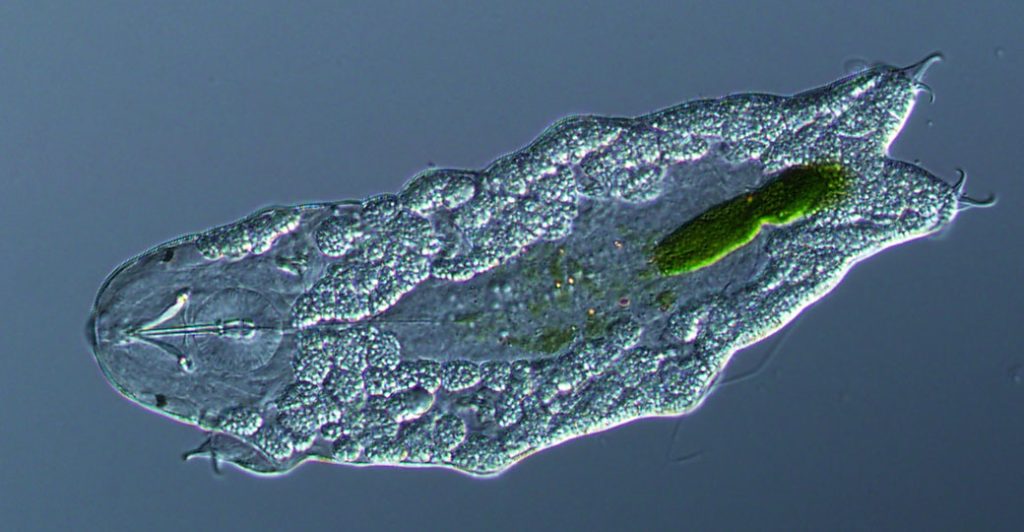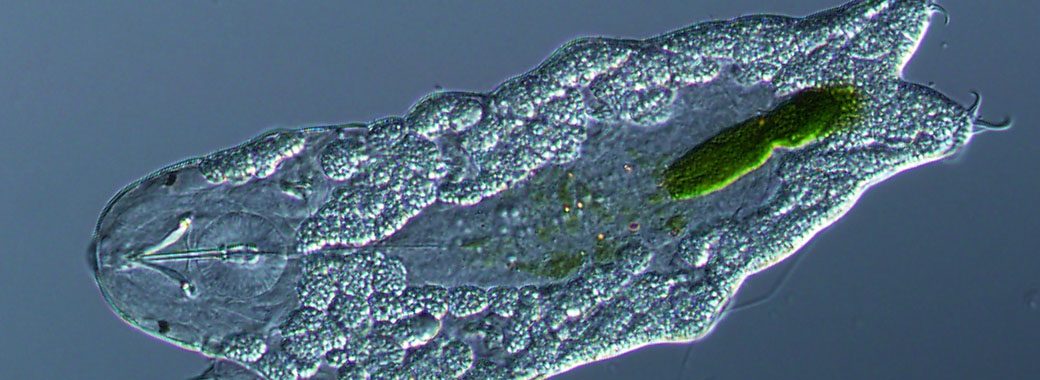Scientists led an international documentary film crew on a ‘water bear hunt’ in Wyoming’s Red Desert. The film crew then followed the scientists as they sent tiny water bears from Wyoming to Florida’s Kennedy Space Center, then on to the International Space Station.
On a windy Wyoming morning, a documentary film crew is clustered around a makeshift lab bench and microscope at the base of the Boar’s Tusk in Wyoming’s Red Desert. Like many folks, the team has come to Wyoming to go hunting. But we aren’t looking for elk or pronghorn. We are on a bear hunt—a water bear hunt, to be precise.
Wait… What’s a water bear?
Water bears, as they are commonly known, or tardigrades to scientists, are a group of microscopic, eight-legged animals. Despite being some of the smallest known animals, water bears are extremely tough—tough enough to survive for years after being dried to a crisp, frozen, and heated up past the boiling point of water. Water bears tolerate thousands of times the radiation that humans can, and they will survive for weeks with little or no oxygen. In fact, water bears are tough enough to survive prolonged exposure to the vacuum of outer space—a feat no other animal has accomplished!
Wyomingites are no strangers to organisms that can survive in extreme environments. Yellowstone is famous for its hot springs and geysers that harbor microbes that thrive in harsh conditions. But instead of thriving under harsh conditions, water bears have evolved to tolerate extremes by entering a state of suspended animation, in which they shut down all their life processes by going into stasis, until favorable conditions return. Whether a day or a decade later, these tiny animals can spring back to life as if nothing happened once their environment becomes hospitable again.
While the microbes in Yellowstone’s hot springs have been studied for decades, almost nothing is known about water bears in Wyoming. In fact, despite finding water bears almost everywhere we have looked, from the mountains to the desert to the UW campus, only one species of tardigrade has been formally described in Wyoming.
My lab’s research focuses on understanding what makes these tiny animals so tough, how they enter and exit stasis, and how we can use this practical knowledge to tackle real-world problems.

What can we learn from studying water bears?
Understanding what makes the diminutive water bear so tough will help us to understand fundamental biological questions, such as how organisms evolve and adapt to new or changing environments. In addition, understanding how organisms survive extreme conditions here in Wyoming, and how extreme those conditions can be, is helping to guide our search for new forms of life, both on Earth and elsewhere in our universe.
Beyond helping us answer fundamental questions, we study water bears for the many potential medical and agricultural biotechnologies that could emerge from understanding what makes these organisms so hardy. For example, if we understand the tricks tardigrades use to stabilize their sensitive cellular components, like proteins and RNA, we might one day develop better ways to stabilize protein- and RNA-based vaccines or crops that can tolerate harsher, more extreme weather such as freezing and drought. But first we need to understand exactly what makes tardigrades so tough.
What makes water bears so tough?
To start to decipher how water bears survive in extreme environments, we studied which portions of their DNA, or genes, they use when exposed to stresses such as drying or freezing. DNA is a molecule that serves as the blueprint for an organism, encoding directions for making other functional molecules, such as proteins, that carry out specific tasks within cells. When we looked at which of these molecular blueprints tardigrades use when stressed, we found something exciting—tardigrades make lots and lots of a very special type of protein.
These special proteins are found only in water bears, meaning organisms such as humans, plants, or bacteria do not have them. When we used genetic techniques to disrupt these proteins, the tough little tardigrades became not-so-tough and could not survive extremes, such as being dried out.
Our experiments have shown that water bears require special proteins to survive extremes, but can those proteins make other organisms as tough as water bears? To answer this question, we attempted to modify bacteria and yeast to make them produce water bear proteins. When we introduced water bear proteins into other organisms, those organisms suddenly became up to 100 times more tolerant to being dried out than they were without the proteins.
Finally, to see if these tardigrade proteins might be protective all by themselves, we figured out a way to isolate and purify them. We found that mixing our water bear proteins with sensitive biological material prevented it from breaking down when frozen or dried.
How can studying water bears help solve real-world problems?
To identify real-world applications for our understanding of tardigrade stress tolerance, we have been working with the Defense Advanced Research Projects Agency to develop ways to store human blood in a dry, unrefrigerated state. Whole blood is extremely sensitive, requiring special cold-storage conditions and chemicals to stabilize it. Even under ideal conditions, whole human blood can only be stored for about 31 days. If conditions are not ideal, the blood can start to degrade in seconds. If we could increase the shelf-life of blood and make it easier to maintain in a range of different environments, medical personnel would have easier access to lifesaving supplies during natural disasters, wars and other austere circumstances.
We also are working to develop new ways to store life-saving pharmaceuticals, such as vaccines, in a dry state without the need for refrigeration or even electricity. This would be particularly useful in remote or developing parts of the world where it can be difficult or impossible to find and maintain the equipment and infrastructure needed to keep vaccines cold and stabilized.
The final frontier
Back in Wyoming’s Red Desert, the documentary crew is wrapping up a long day of filming and hunting for water bears. They have come to Wyoming to cover our preparations to launch our water bears into space, and in August 2021, that is exactly what we did. Our tiny, robust water bears traveled from Wyoming to the Kennedy Space Center, then up to the International Space Station. Onboard the Space Station, an international team fed and monitored our animals for two months, long enough for these fast-reproducing animals to produce four generations of offspring.
The purpose of our mission was to monitor how water bears deal with the stress of space travel over multiple generations, important because space is an extremely inhospitable place for organisms—like humans—that evolved on Earth. The lack of gravity and increased radiation in space are extremely detrimental to our health and biology—but tardigrades don’t seem to mind. By studying how water bears cope with the stresses of spaceflight, we hope to develop therapies and countermeasures to safeguard astronauts on extended missions to deep space.
By Thomas Boothby, Assistant Professor, Department of Molecular Biology, (307) 766-4993, thomas.boothby@uwyo.edu.
Reprinted from Reflections 2022. Reflections is UW College of Agriculture, Life Sciences and Natural Resources’ annual research magazine. Visit http://www.uwyo.edu/uwexpstn/publications/reflections/index.html to download the 2022 issue.





